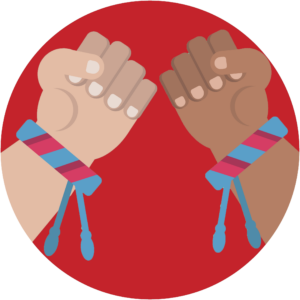Page Contents

Page Contents

HIV transmission between mother and child can occur during pregnancy, delivery (childbirth), or while breastfeeding. Due to increased testing and treatment given to mothers before their baby is born, very few children born to an HIV-infected mother will acquire the virus. In the U.S., the mother-to-child transmission has decreased to 1%. Here’s more on the ways that children can contract HIV:
A child can be born with HIV or contract it soon after birth. HIV contracted during a pregnancy is called perinatal transmission or vertical transmission. HIV transmission to children can happen during the gestation period where the virus could be passed from the mother to the baby through the placenta. The transmission can also take place during the time of delivery through transfer of blood or other bodily fluids and also through breastfeeding. In the United States, vertical transmission is the most common way children under age 13 contract HIV.
The CDC recommends mothers with HIV to avoid breastfeeding their infants to prevent HIV transmission.
Secondary transmission, or horizontal transmission, is when HIV is transferred by contact with infected semen, vaginal fluid, or blood.
Children and teens who share needles, syringes and similar items are also at risk for contracting HIV. Additionally, HIV can be transmitted through infected blood in healthcare institutions like hospitals and clinics.
The treatment for HIV positive children is Antiretroviral Therapy. The child should be started on antiretroviral treatment immediately. Once your child has started treatment, it’s important that they take it every day. Your healthcare professional will explain how much of the medication (the dose) you need give your child. This will change as your child grows. Some types of HIV medication for babies and young children are available as liquids or syrups. Contact your healthcare professional to get more details on the treatment.
Learn more about HIV in children and teens at: stanfordchildrens.org/ or healthline.com/health/hiv-in-children. Or read the following AIDSinfo fact sheets:
Young people are vulnerable to HIV at two stages of their lives: early in the first decade of life when HIV can be transmitted from mother-to-child, known as vertical transmission (see children and HIV), and the second decade of life when adolescence brings new vulnerability to HIV. Unprotected sex is the most common route of HIV infection for young people while sharing infected needles is the second. Intergenerational sex also contributes to the rising number of HIV positive patients in the youth. Older partners are more likely to be living with HIV, therefore risking exposure to young people, and are more likely to expose a young person to unsafe sexual behaviors such as low condom use.
Abstinence from sexual intercourse and delayed initiation of sexual behavior are among the central aims of HIV prevention efforts for young people. Decreasing the number of sexual partners and increasing access to, and utilization of comprehensive prevention services, including prevention education and increasing access to condoms are essential for young people who are sexually active.
Do not mix drinking or using drugs with sex. Youth who drink and/or use drugs may be more likely to take risks, such as not using protection during sexual activity, when they are drunk or high. This can increase their risk of getting HIV or other STIs.
Learn more at: https://www.hiv.gov/hiv-basics/hiv-prevention/reducing-risk-from-alcohol-and-drug-use/substance-use-and-hiv-risk or avert.org/professionals/hiv-social-issues/key-affected-populations/young-people.
Living with HIV presents certain challenges, no matter your age. But older people with HIV may face different issues than their younger counterparts, including the potential for greater social isolation and loneliness. Stigma is also a particular concern among older people with HIV. Therefore, it is important for older people with HIV to get linked to HIV care and have access to mental health and other support services to help them stay healthy and remain engaged in HIV care. You can find support services through your healthcare provider, your local community center, or an HIV service organization. For local resources, please refer to our local resources page.
Life-long treatment with HIV medicines (called antiretroviral therapy or ART) is helping people with HIV live longer, healthier lives. The choice of an HIV regimen for an older person is based on the person’s individual needs. Conditions, such as heart disease or cancer, require additional medical care. Older people are also prone to heart conditions and other age-related diseases. The main factor that complicates HIV treatment is the side effects from HIV medicines and other medicines. Mixing different types of medication can cause side effects. It is advisable to contact your health care provider to prevent and mitigate the side effects of different medications.
Learn more at: aidsinfo.nih.gov/understanding-hiv-aids/fact-sheets/25/80/hiv-and-older-people.
According to the U.S. Centers for Disease Control and Prevention (CDC), there are 1.2 million people living with HIV (PLWH) in the United States. Gay and bisexual men made up an estimated 2% of the U.S. population in 2013 but 55% of all PLWH in the United States. Transgender people have also been hit especially hard by HIV despite comprising a similarly small percentage of the U.S. population. Risky behaviors, like having anal or vaginal sex without a condom, not adhering to HIV treatment, and sharing needles play a big role in HIV transmission in the LGBTQ community. Anal sex is the highest-risk sexual behavior. But there are more tools available today to prevent HIV than ever before. Choosing less risky sexual behaviors, taking medicines to prevent and treat HIV, and using condoms with lubricants are all highly effective ways to reduce the risk of getting or transmitting HIV.
Within the HIV response, leaving no one behind is both a moral and human rights imperative and a public health necessity. LGBT people face multiple HIV-related vulnerabilities, fueled by inequalities and prejudices and entrenched within the legal, social and economic structures of society.
Learn more at: www.hrc.org/resources/hrc-issue-brief-hiv-aids-and-the-lgbt-community or hiv.gov/hiv-basics/overview/.
The content for this page was compiled from several public information sources. We would like to thank and give credit to the following sources:
Children
Youth
Elderly Living with HIV
LGBTQ+ Living with HIV